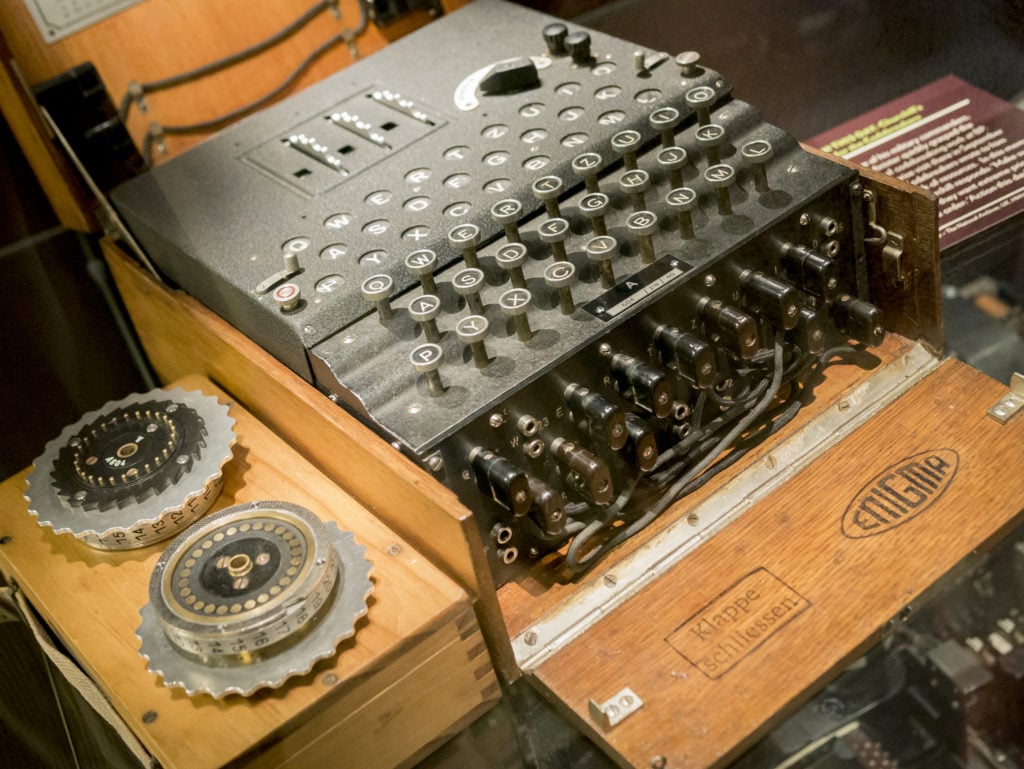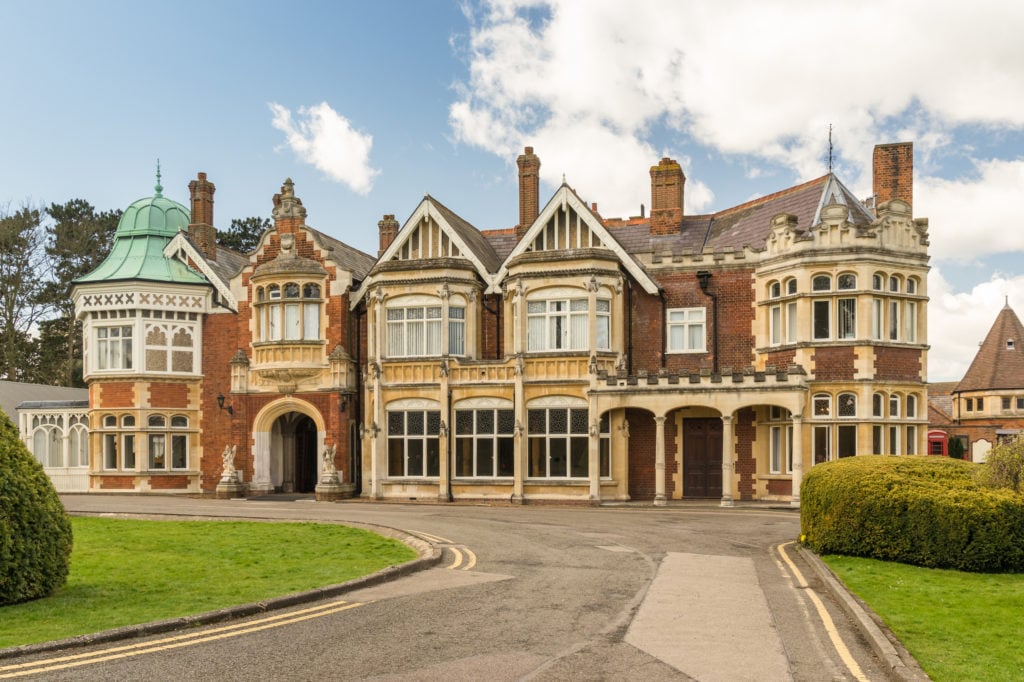In 1918, German scientist Arthur Scherbius developed a code-generating machine, called the Enigma, that would prove to be incredibly resistant to code-breaking efforts—and likely would have handed victory in WWII to the Axis powers, if not for the intervention of a team of Allied heroes.
Although the Enigma was developed in 1918, it wasn’t thoroughly tested and ready for use until 1923. At first, only commercial models—those ostensibly intended for nonmilitary use—were available. These machines were quite sophisticated, but the German military command wanted even stronger cryptography at their disposal, so they committed enormous resources to the development of a military-only version of the Enigma.1
The first versions of the Enigma machine were mechanical devices similar in appearance to an old cash register, with twenty-six keys (for the letters A–Z) and three internal wheels, with the same twenty-six letters printed on each. Each wheel would be set to a specific position, determined by a master code that would be changed daily. Each time a key was pressed on the machine, the rightmost wheel would rotate one position and print a letter other than the one pressed. Once the wheel had rotated through all twenty-six letters, the adjacent wheel would be advanced one position and the cycle would begin anew. Decoding Enigma messages required another machine set with the same key cipher, whereby the encoded message could be typed in and converted back to its original text. Later, more sophisticated models would employ additional wheels and more complicated mechanical processes to make the code even more formidable.2
In 1926, the German military began field-testing multiple updated versions of the Enigma machine. Several European countries—particularly Poland—had been monitoring Enigma transmissions since they had first detected them, but as late as 1929, Poland had made no serious attempts to decode them. In the following year, the Polish Cipher Bureau—now acutely aware of the growing likelihood of a second World War—tasked three brilliant mathematicians from the University of Poznan with breaking the Enigma code. Marian Rejewski, Jerzy Różycki, and Henryk Zygalski got to work, using little more than pencils, paper, a handful of intercepted German military messages, and a vague description of an outdated commercial model of the Enigma machine.
In late 1932, Rejewski made the team’s first significant breakthrough when he successfully deduced the complex internal wiring that the Enigma machines used and thus was able to devise rudimentary handwritten code-breaking algorithms. Rejewski’s discovery, along with Zygalski’s subsequent “Zygalski sheets” (a complex series of punch cards that could be overlaid onto Enigma messages to expedite the decryption process), later would be used to construct the first machine capable of cracking Enigma codes automatically.3
In 1933, a German Cipher Office employee named Hans Thilo Schmidt approached the Polish Cipher Bureau offering to sell top-secret Enigma schematics.4 The bureau accepted his offer, and over the following five years, the three Poznan mathematicians used the schematics to successfully decrypt many intercepted Enigma messages. By 1938, it was clear that Germany was preparing for war.
Suddenly, on September 15, 1938, the Polish code breakers began receiving messages encoded by completely new and different ciphers, which their reconstructed machines were unable to break. This new code was far more complicated than anything they’d encountered so far. They would learn later that the Germans had added two more cipher wheels to their Enigma machines, increasing the number of possible keys by a factor of twenty. With the threat of war looming, Poland started looking for allies with whom to collaborate on code-breaking efforts.
Meanwhile, famed British WWI code breaker Dillwyn “Dilly” Knox was also working to decipher Enigma codes, but his success was limited compared to that of the Polish team. In 1938, his employer, the British Government Code & Cipher School, officially began collaborating with the Deuxième Bureau (France’s intelligence agency), to whom Schmidt had also sold Enigma schematics.5
By 1939, with the outbreak of WWII imminent, Poland, France, and Britain formed an official code-breaking team comprised of the best mathematical and linguistic minds from each country, including Alan Turing. At the time, Poland had the most advanced counter-Enigma devices, and it readily shared them. The code-breaking team took up residence at Bletchley Park, a luxurious British estate, in August 1939, and would remain there throughout the war, which Germany would start just a few weeks later when it invaded Poland on September 1.6
Fortunately, the Polish Cipher Bureau had anticipated the invasion and destroyed all of its Enigma-related materials, leaving the only surviving copies with the international team at Bletchley Park and with British and French intelligence offices. At the start of the war, Germany suspected that Poland had been monitoring its transmissions but would remain in the dark for some time about how effective the Polish team had been at decoding them.
Rejewsky (a mathematician) and Knox (a linguist) found that their different approaches to code breaking complemented one another, and the two soon became fast friends. They often would stay up late, working on the Enigma codes long after most of the others had gone to bed. Turing, too, often would forgo sleep as he worked ceaselessly at finding ways to automate the team’s pen-and-paper algorithms, which were becoming increasingly inefficient as the Enigma codes became exponentially more complex.
By 1940, the code breakers were able to decode most messages from the Luftwaffe (German air force) and some from the army, but the German navy used far more complex ciphers that still were completely incomprehensible to the Allies. The Bletchley Park team later discovered that the German navy used entirely different Enigma machines that had eight cipher wheels, compared to five on most other models. (This put the number of possible wheel order combinations at 40,320, not to mention the staggering number of possible starting positions of each wheel.)
In 1941, a German U-boat was captured by Allied forces, and advanced Enigma codebooks were recovered from it, which enabled Turing and his colleagues to partially decode the inordinately complex naval transmissions. Also in that year, Winston Churchill proposed the creation of a “Top Secret Ultra” classification and designated the Bletchley Park code-breaking project as such, meaning that its members and resources were to be protected at all costs and above all other concerns. This classification would be adopted and used more generally by Britain and other countries after the war, but at the time, the Bletchley Park project was the only one deemed important enough to receive the designation.7
The recovered codebooks enabled the Allies to win a few scattered victories against the mighty German navy, but their newfound advantage was to be short lived. In February 1942, the German navy abandoned its previous codes and began using yet another new Enigma machine, rendering Turing’s earlier automation efforts almost entirely moot. The code-breaking team, now unable to decode any naval transmissions, was plunged into an information blackout that lasted for eight months, during which the German Wolfpack (U-boat fleets) wreaked havoc on American supply ships bound for England. Many Allied lives and huge caches of supplies were lost.
In October of that year, the Allies captured another U-boat and recovered updated codebooks. The timing was perfect, as Turing had just finished dissecting a newly captured Enigma machine, and the new codebooks were the missing puzzle piece he’d been looking for. However, England, France, and Poland were all short on resources—too short to build large numbers of the newest code-breaking machines. America, however, had ample resources and volunteered to mass-produce them—and to design subsequent versions as Allied forces continued to recover new intelligence from German U-boats.
The first American Enigma code-breaking machine was designed in 1942 by Joe Desch, an engineer at the National Cash Register company in Dayton, Ohio. By the end of 1943, American code breakers had fully joined the Allied intelligence fight and had taken responsibility for breaking the most complex German naval codes, while the Bletchley Park team continued working on Luftwaffe and army transmissions. As the Allied forces suddenly began to dominate naval battles, the German military launched several investigations meant to determine whether their codes had been compromised. Each time, however, they arrogantly concluded that the Enigma code was completely unbreakable and that there was no way that the Allies could be deciphering their messages. In fact, also in 1943, a German scientist named Regierungs-Oberinspector Fritz Menzer developed an enormously complex Enigma cipher wheel that very well might have stymied the Allied code breakers indefinitely, but the German military initially refused to use it, calling it “unnecessary.” They still believed that the Allies were incapable of breaking the current Enigma codes.8
In 1942, largely thanks to the combined efforts of all of the Allied code breakers, the Allied forces were able to wrest Egypt from the control of German General Erwin Rommel, which significantly hampered Germany’s ability to strike northwest into France. As British General Harold Alexander put it, “The knowledge not only of the enemy’s precise strength and disposition, but also how, when and where he intends to carry out his operations brought a new dimension to the prosecution of the war.”9 Germany surrendered in May 1945, before Menzer’s new Enigma cipher wheels could be mass-produced and deployed in the field (by then, the German military command were convinced of the need for them, but thankfully, it was too late). Japan wouldn’t surrender until later that year, but one of the biggest ideological threats to human life in the 20th century had been defeated—by Rejewski, Rózycki, Zygalski, Turing, Knox, and the other Bletchley Park code breakers who recognized the incredible power of the human mind and employed it to save countless lives.
Click To Tweet
You might also like
Endnotes
1. Crypto Museum, “History of the Enigma,” January 27, 2019, https://www.cryptomuseum.com/crypto/enigma/hist.htm.
2. Dirk Rijmenants, “Technical Details of the Enigma Machine,” Cipher Machines and Cryptology, http://users.telenet.be/d.rijmenants/en/enigmatech.htm (accessed July 1, 2019).
3. Crypto Museum, “Bombe,” January 3, 2019, https://www.cryptomuseum.com/crypto/bombe/index.htm; Marian Rejewski, “The Mathematical Solution of the Enigma Cipher,” Appendix E to Wladyslaw Kozaczuk, Enigma (New York: Hippocrene Books, 1984), 289; Crypto Museum, “History of the Enigma.”
4. Schmidt’s motives appear primarily to have been financial. Nonetheless, he deserves some credit for his role in helping the Allies win the war.
5. Crypto Museum, “History of the Enigma.”
6. Francis Harry Hinsley and Alan Stripp, Codebreakers: The Inside Story of Bletchley Park (Oxford: Oxford University Press, 2001), 90.
7. Crypto Museum, “History of the Enigma.”
8. National Security Agency, “Regierungs-Oberinspektor Fritz Menzer: Cryptographic Inventor Extraordinaire,” https://www.nsa.gov/Portals/70/documents/news-features/declassified-documents/cryptologic-quarterly/Regierungs_Oberinspektor.pdf (accessed July 1, 2019); Crypto Museum, “History of the Enigma.”
9. Andrew Lycett, “Breaking Germany’s Enigma Code,” BBC History, February 17, 2011, https://www.bbc.co.uk/history/worldwars/wwtwo/enigma_01.shtml.


![[TEST] The Objective Standard](https://test.theobjectivestandard.com/wp-content/uploads/2017/10/logo.png)















